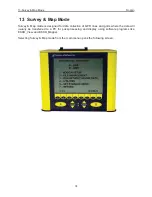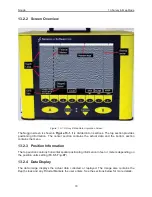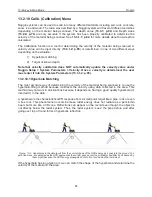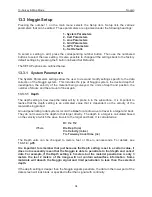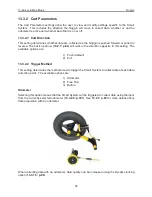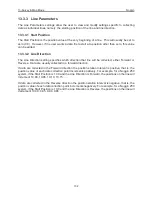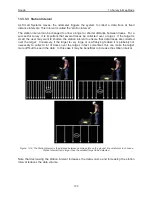
13-Survey & Map Mode
Noggin
88
13.2.10 Calib. (Calibration) Menu
Noggin systems can be used to scan into many different materials including soil, rock, concrete,
snow, ice and wood. The radio wave emitted by a Noggin system will travel at different velocities
depending on the material being scanned. The depth value (
13.3.1: p.94
) and Depth Lines
(
13.2.4: p.79
) are only accurate if the system has been properly calibrated to determine the
velocity of the material being scanned. See
13.3.1.1: p.94
for more details about how depth is
calculated.
The Calibration function is a tool for determining the velocity of the material being scanned. A
velocity value can be input directly (
13.3.1.2: p.95
) or determined in one of two different ways
depending on the situation:
1)
Hyperbola matching
2)
Target of known depth
Note that velocity calibration does NOT automatically update the velocity value under
Noggin Setup > System Parameters > Velocity. Once a velocity is determined, the user
must enter it into the System Parameters (13.3.1.2: p.95).
13.2.10.1Hyperbola Matching
The most accurate way of determining the velocity of the material being scanned is to use the
hyperbola-fitting method because it extracts the velocity using data collected in the area. This
method may not work in all situations because it depends on having a good quality hyperbola (or
inverted U) in the data.
A hyperbola is the characteristic GPR response from a small point target like a pipe, rock or even
a tree root. This phenomenon occurs because radar energy does not radiate as a pencil-thin
beam but more like a 3D cone. Reflections can appear on the record even though the object is
not directly below the radar system. Thus, the radar system “sees” the pipe before and after
going over top of it and forms a hyperbolic reflection.
Figure: 13-2 Hyperbolas in the data result from the conical shape of the GPR energy as it goes into the ground. Tar-
gets, like pipes, are detected as the GPR approaches them (left), passes over them (middle) and after it has passed by
them (right) because the GPR energy propagates both in front and behind the instrument.
If the hyperbola has long tails on it, we can match the shape of the hyperbola and determine the
velocity of the material in the area.
Содержание Noggin 100
Страница 1: ...User s Guide Copyright 2012 Sensors Software Inc 2011 00022 02 Noggin ...
Страница 2: ......
Страница 4: ......
Страница 8: ......
Страница 17: ...Noggin 2 Noggin Components 3 Figure 2 3 Noggin 100 components ...
Страница 156: ...Appendix D Instrument Interference Noggin D 2 ...
Страница 158: ...Appendix E Safety Around Explosive Devices Noggin E 2 ...
Страница 162: ...Noggin G 4 ...

